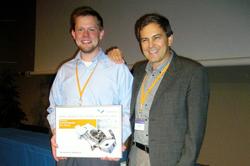Kenneth Beyerlein receives EPDIC young scientist award
Figure 1. CFEL/DESY scientist Kenneth Beyerlein (left, pictured here with Professor Paolo Scardi) received the Young Scientist Award at the European Powder Diffraction Conference (EPDIC) in Grenoble, France, on October 31, 2012.
CFEL scientist is honored for outstanding nanomaterials research
By Manuel Gnida
The European Powder Diffraction Conference (EPDIC) honored Kenneth Beyerlein with the 2012 Young Scientist Award in Grenoble, France, this Wednesday. Beyerlein, a postdoctoral scientist in the Chapman group at the Center for Free-Electron Laser Science (CFEL), received the highly competitive and prestigious award in recognition of his outstanding graduate research work on modeling and interpreting powder diffraction patterns from nanoparticles.
Nanotechnology is one of the “hot topics” of modern day science. Nanometer-sized materials (one nanometer is a millionth of a millimeter) are already widely used in products such as sunscreen, water-repellant surfaces, scratch-resistant car finishes, and wear-and-tear-reducing motor oils. Promising future applications range from nanowires in novel data storage devices to nanorobots administering drugs to cancer cells in the human body.
“Industry is abuzz over the concept of nanotechnology right now,” awardee Beyerlein says. “As this industry matures and products are produced on a large scale, it will be important to characterize them to ensure their quality and reproducibility.” A powerful method to study minuscule nanomaterials is X-ray powder diffraction. Similar to doctors using X-rays to look into a patient’s body, researchers utilize X-rays to probe mixtures of nanoparticles and determine their properties. “I am hopeful that my research will set the stage for powder diffraction to be reliably used as [a characterization] tool,” says Beyerlein.
As a graduate student, Beyerlein studied under Professors Bob Snyder and Mo Li at the Georgia Institute of Technology (Atlanta, USA) as well as Professor Paolo Scardi at the University of Trento (Italy), where he developed new approaches to determine the shapes and sizes of nanoparticles from powder diffraction data. Furthermore, the award-winning research led to an improved understanding of the effects that heat-induced vibrations, surface structure, and structural imperfections have on the diffraction signals of nano-sized crystals.
“We have found new effects on the diffraction pattern from small crystals and begun developing the theory to explain them,” Beyerlein says. “My work has predicted that the effect of deformation faults [in crystals] depends not only on the number of faults but, just as importantly, on how close they are to the surface of a crystal.” Studies of surface effects will benefit chemical catalysis research, for instance, because a catalyst’s efficiency is linked to its surface properties.
At CFEL, Beyerlein transfers the results of his graduate research to the emerging field of protein nanocrystallography using X-ray free-electron lasers. Although structural biologists have been using diffraction techniques for many years, challenging proteins forming only nano-sized crystals have not been accessible in previous studies. “The work of the Chapman group has shown that [a protein] structure can be solved with the patterns from a few thousand nanocrystals,” Beyerlein says. “The same idea that I used to characterize the size and shapes of nanomaterials can be applied to studying small protein crystals.” Biomedical and pharmaceutical applications greatly benefit from a detailed knowledge of protein structures. Hence, nanocrystallography is expected to provide a new impetus for these research areas.
EPDIC recognizes the outstanding scientific achievements by a young researcher in the field of powder diffraction once every two years. “EPDIC has been a constant source of inspiration and knowledge for me,” Beyerlein says. “It is truly an honor to receive this award.”
